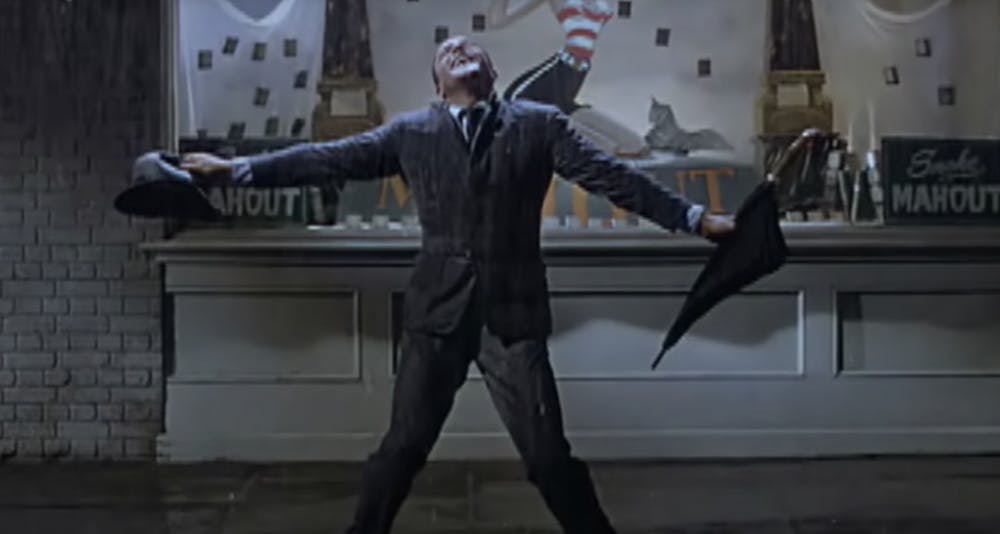Musicals are having a moment right now at the box office. La La Land was a hit in 2016, and this year The Greatest Showman is popular not only in theaters, but also on streaming charts (with its original song “This is Me” racking up millions of plays on airwaves and services like Spotify). The success of these movie musicals is not unprecedented. Once upon a time, original movie musicals were popular and commonplace. After a dry spell that lasted decades, the industry is finally back at it—and if you’re loving it like we are, it’s worth going back to some of the old standards that inspired these films and came before them.
Singin’ in the Rain (1952)
Everyone knows this one, but it’s still a necessary inclusion; a list of the best movie musicals would not be complete without Singin’ in the Rain. A story of Hollywood’s transition from silent films to “talkies,” there is no better celebration of the possibility of film and sound together. Singin’ in the Rain was written to be a movie, not as an adaptation of an already existing musical, and while Hollywood would later go the easy route of churning out Broadway adaptation after Broadway adaptation, Singin’ in the Rain shows us the value of originality. Numbers like “Make ‘Em Laugh” and “Moses Supposes” work because they were meant to be filmed. Singin’ in the Rain is a homage to two worlds, and an exuberant celebration of both the power of film and the power of musical theater, together and without contradiction.
Meet Me In St. Louis (1944)
The Wizard of Oz is an indisputable classic, but it’s not the only Judy Garland musical. The lesser known Meet Me in St. Louis is a wonderful romance in its own right, but it’s also a delightful relic from a time when it was perfectly acceptable to write a love story and throw musical numbers in for fun. Meet Me in St. Louis is an old movie, telling an antiquated story (the plot revolves around the world’s fair of 1904), but there’s an ageless grace and appeal brought to the film by Garland; when she sings “The Trolley Song” or smiles at John Truett, it’s easy to see how generations of leading ladies have drawn inspiration from her.
Stormy Weather (1943)
Avowed skeptics of musicals are not short of criticisms to offer of the genre, but even those who adore them would be hard pressed to deny one of the realest and most concerning problems in the genre—diversity. Although current hits like Broadway’s Hamilton are currently changing perceptions, for many years musical theater—both on film and on stage—was dominated by white actors, white narratives, and whitewashing (think Natalie Wood in West Side Story). This aversion to diversity has to be the reason that Stormy Weather, and all of the black talent it showcases, has been overlooked and uncelebrated for years. Fred Astaire once called the dance routine the Nicholas Brothers perform in “Jumpin’ Jive” the “greatest dancing he had ever seen on film,” and as much as we love him and Ginger, we think he’s right; their names might not be as familiar, but Fayard and Harold have both of them beat.
The Umbrellas of Cherbourg (1964)
Not a fan of mainstream American cinema? There’s a movie musical for you, too. The show–stopping numbers and big effects of many movie musicals can make them feel thoroughly Hollywood, but for the artsier crowd, The Umbrellas of Cherbourg is a delightful subversion. The brainchild of French New Wave director Jacques Demy, The Umbrellas of Cherbourg tells the story of a young couple’s love and the tragic turn their lives take when she becomes pregnant and he is drafted to fight in the Algerian War. Everything is sung, opera–style, and while the sets, backdrops, and costumes explode with vibrant color, much of the music is quiet and understated. The Umbrellas of Cherbourg is a bittersweet story, a visual marvel, and proof that the movie musical can be as versatile as a director is inventive.







